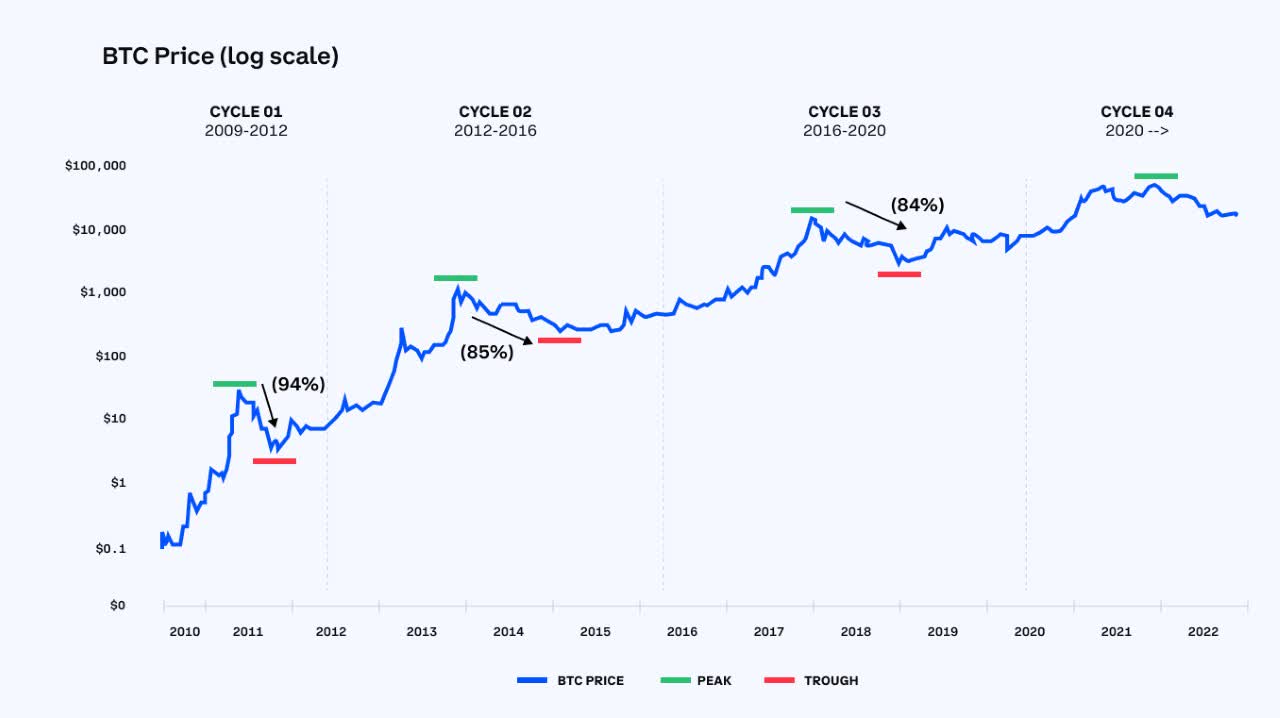CryptoLogs: 2022 Coinbase 10-K Takeaway
We are
The first US ETF with “crypto” in its name was the Bitwise Crypto Industry Innovators ETF (BITQ), which launched on May 21, 2021. Before that, there were very few public crypto stocks. The most famous IPO was Coinbase Global (COIN) which did not occur until April 14, 2021. Coinbase’s IPO coincided with the growth of the crypto industry which peaked in 2021 when Bitcoin (BTC-USD) hovered around the ~$60,000 range. In the ETF world, this was followed by several ETF launches, not only from crypto-focused companies like Bitwise, but also traditional players like Invesco, Schwab and Fidelity. The launch as a public company also gave investors and analysts an important advantage – public SEC filings with insight into both industry and company data. Coinbase is currently one of the largest constituents (4.3% index weight) in Alerian Galaxy Global Cryptocurrency-focused Blockchain Equity, Trusts and ETPs Index, which is the underlying index for Invesco Alerian Galaxy Crypto Economy ETF (SATO). The following are takeaways from Coinbase’s most recent 10-K published on February 21, 2023, including industry insights and updates from the 2021 to 2022 10-K.
Coinbase adjusts its business model through crypto asset cycles. In the business overview portion of the 2022 10-K, Coinbase added a section discussing asset price volatility and crypto cycles. The company points to four major cryptoasset price cycles that have occurred since 2010 with each cycle lasting roughly two to four years (illustrated in the chart below that was also recently included in this year’s 10-K). Due to limited ability to predict the crypto cycle and forecast revenue, the company has implemented cost-cutting measures including workforce reductions to maintain profitability through downturns. The company reduced its headcount by 18% in June 2022, followed by another 21% reduction in its workforce in January 2023. Coinbase believes that the latest workforce reduction will reduce technology, sales and marketing, and general and administrative expenses by 30% year-over-year in 1Q23. Coinbase has also stated that it will take a more “rigorous approach” to investments in new products and also added language that shifts away from its historically acquired business. In 2022, the company recorded $101.4 million in gross impairment charges due to strategic investments and acquisitions that performed worse than expected due to economic conditions.
Coinbase Global 2022 10-K
Increased focus on subscription income including interest income from USDC. Transaction revenue made up 91.4% of the company’s net revenue in 4Q21, but only 53.2% of net revenue in 4Q22. This was mainly due to lower asset prices and lower trading volumes, but also due to an increase in subscription revenue which mostly came from USDC (a stablecoin backed by the US dollar). The higher interest rate environment contributed to both higher interest income from USDC and interest earned from customer fiat balances on the platform. However, the company states that if interest rates were to drop significantly from 2022 levels, subscription revenues could also drop significantly.
Coinbase addresses custody and failure of FTX, Celsius Networks, Voyager and Three Arrow Capital. While Coinbase claims to have no significant direct impact, it notes that these 2022 events caused changes in crypto market prices, crypto market volatility and customer sentiment. In particular, it includes loss of confidence in the broader crypto economy, damage to the reputation of crypto platforms such as Coinbase, negative publicity, and increased scrutiny from regulators and lawmakers. They also reiterated holding assets 1:1 and not lending or remortgaging client assets. In June 2022, the company updated its retail user agreement to provide legal protection to custodial crypto assets in the event of a bankruptcy. However, Coinbase cautions that due to the novelty of cryptoassets, courts have yet to consider this type of treatment for custodial cryptoassets.
Regulatory and legal classifications such as raw materials vs. securities are still highly debated. Based on language from both the Commodity Futures Trading Commission (CFTC) and the Securities and Exchange Commission (SEC), certain cryptoassets may be classified as commodities and some may be classified as securities. But there is no clear or consistent classification framework. Coinbase added language in its filing referring to itself as “asset-agnostic” and seeking to access all assets where it is safe and legal to do so. But despite this language change, customers have returned their focus back to the basics – Bitcoin and Ethereum (ETH-USD). In 4Q21, Bitcoin and Ethereum each contributed 16% to trading volume, with the remaining 68% going to other cryptoassets. But in 4Q22, Bitcoin had 35% of Coinbase’s trading volume, Ethereum had 33% of trading volume, and other cryptoassets were only 33%.
The company will no longer disclose verified users. For the year ending 2022, the company reports a 24% increase in verified users which includes all consumers, institutions and developers who have a registered account on the platform. The company previously used this metric as an indication of scale; however, they no longer believe that this metric provides meaningful insight into the business’s performance, so this metric will be discontinued in the next 1Q23 earnings report. While a change in metrics can be seen as a negative, this change seems rational since verified users track registration and not necessarily activities that lead to monetization.
Bottom line:
While the crypto economy remains volatile, major crypto companies like Coinbase are able to adapt their business to changing market conditions. Because the crypto economy is still in its early stages, it is extremely difficult to time the market and pick stocks within this sector – even with the added clarity provided by public SEC filings. With crypto ETFs holding 9 of the top 10 spots for highest performing stock ETFs YTD, investor interest has returned to crypto. Rule-based index-based products such as ETFs can give an investor exposure to the crypto-economy, while diversifying away some of the aforementioned individual share risk.
The Alerian Galaxy Global Cryptocurrency-Focused Blockchain Equity, Trusts and ETPs Index (CRYPTO) is the underlying index of the Invesco Alerian Galaxy Crypto Economy ETF (SATO).
VettaFi LLC (“VettaFi”) is the index provider for SATO, for which it receives an index license fee. However, SATO is not issued, sponsored, endorsed or sold by VettaFi, and VettaFi has no obligation or responsibility in connection with the issuance, administration, marketing or trading of SATO.
Dissemination: © VettaFi LLC 2023. All rights reserved. This material is prepared and/or issued by VettaFi LLC (“VettaFi”) and/or one of its consultants or affiliates. It is provided as general information only and should not be taken as investment advice. VettaFi employees are prohibited from owning individual MLPs. For more information about VettaFi, visit www.vettafi.com.
Original post
Editor’s note: The summary points for this article were selected by the Seeking Alpha editors.


